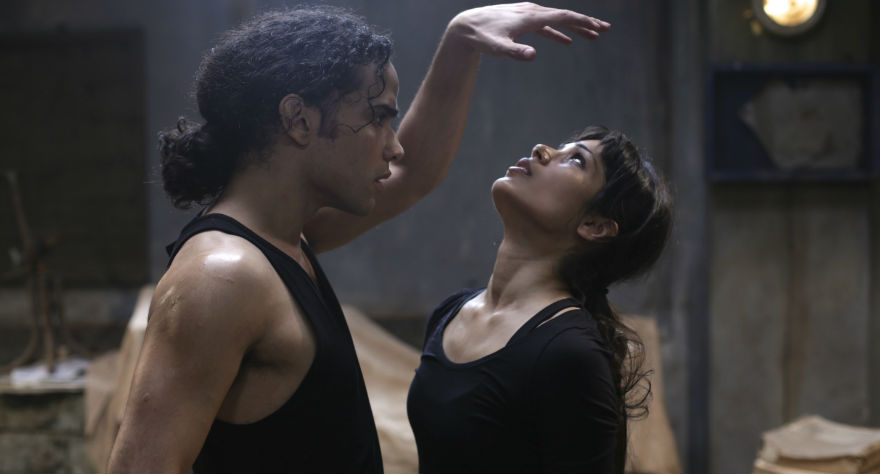
Sabotaged by clichés and occasional hokeyness, Raymond's film is at its best when wordless.

Sabotaged by clichés and occasional hokeyness, Raymond's film is at its best when wordless.
Chronicling the true story of Iranian artist Afshin Ghaffarian, Desert Dancer is defined by its highs and lows. The stuff you’d expect from a movie called Desert Dancer—that is, dancing…in the desert—is delivered in full by first-time director Richard Raymond, and it’s really good. Though they don’t all take place on sand dunes, the film’s dance scenes are things of beauty, sweeping, wordless tributes to the human body in motion that express the characters’ emotional state better than any words could. Problem is, the rest of the film in between the dance scenes is chock-full of words: hokey, uninspired dialogue, Hollywood clichés, and a superfluous love story sabotage a film that should have been about art’s power to make change, but instead winds up being a formulaic ensemble drama.
Nevertheless, the dancing is great, and a lot of that is due to the context by which it’s framed: for dancing, these people could be killed. Reece Ritchie plays Ghaffarian, a student at the University of Tehran who starts an underground dance troupe with a handful of brave, plucky activist friends, played by Bamshad Abedi-Amin, Tom Cullen, and Marama Corlett. Joining the group later is Elaheh (Freida Pinto), a talented interpretive dancer who quickly emerges as the star player. The troupe must stay underground because dancing is forbidden by the Iranian government, and dancing in public could get you arrested, or worse, murdered by fundamentalist goons on the streets.
Excluding Elaheh, the dancers are all beginners, learning all their moves from YouTube (before Elaheh takes the reins, that is) and practicing in an abandoned warehouse. As their act begins to come together, Ghaffarian convinces the group that they should perform in public. Problem is, the Iranian regime and its followers are ubiquitous as hell, so they’ll have to find somewhere secluded. They decide on putting on their modern dance masterpiece in the desert, inviting a small group of select, progressive young folks to be their audience. If word gets out about the show, it could spell their doom, but the feeling of freedom, to them, would be worth every drop of blood.
On a grand scale, Ghaffarian’s story of putting his life on the line to create art is poignant and inspirational. It’s a stirring reminder of art’s true vitality. But the film loses focus constantly, throwing in protracted subplots that sap the gravity out of the story. The most egregious of these detours is Ghaffarian’s romance with Elaheh, who happens to be a heroin addict as well as a gifted dancer. Watching him nurse her back to health adds little to the overarching story, and in hindsight, after seeing how the film ends, this chapter feels completely unnecessary. Pinto and Ritchie’s performances are good, though, so it’s not a total loss.
There are some strange decisions made throughout the film that make it feel somewhat impure. The threat of death doesn’t feel as menacing as you’d think it would, and when violence is shown, Raymond seems to hold back. The characters also speak to each other exclusively in English, which feels odd, especially when they’re discussing things like policies of the Iranian government. This was clearly a film made for Westerners, and as a result it feels less earnest at times. When the characters stop speaking with their mouths and start speaking with their bodies is when things click.
What’ll stick in your mind the most after watching Desert Dancer are the gorgeous dance sequences, each of which is memorable. When Elaheh auditions to be in the dance company, she busts out into an interpretive routine full of undulating motions and delicate swoops of the arm. The music is minimal, accentuating the haunting quality of the performance. The climactic dance in the desert, a three-way routine between Ritchie, Pinto, and Cullen, is a breathtaking display of physical storytelling, as is Ritchie’s solo performance in the film’s final act, which takes place on a theater stage in Paris.
Desert Dancer‘s finale is where it really comes together, Ghaffarian spilling his heart out about the horrific oppression he and his friends have been subjected to back in Iran. What makes it so good (aside from how outstanding Ritchie is), is that the movie finally gets straight to the point: Ghaffarian lived in a world where he wasn’t allowed to be himself, not allowed to be human, a reality he refuses to accept. It’s his ambition and relentless drive to express his true feelings that make his story so extraordinary, and though Raymond takes the long road to get there, he eventually gets it across.